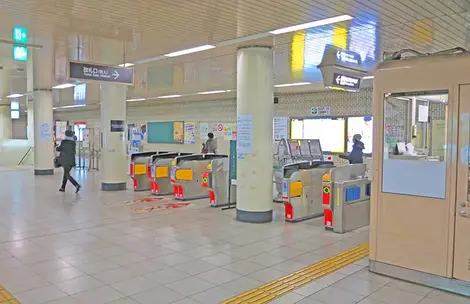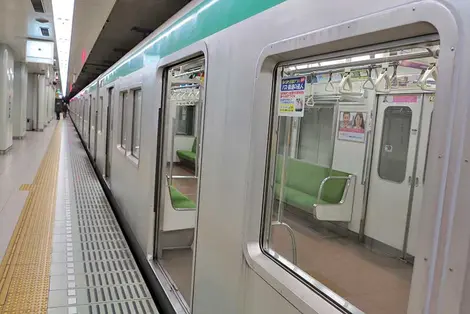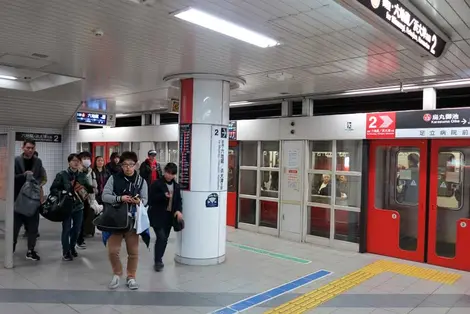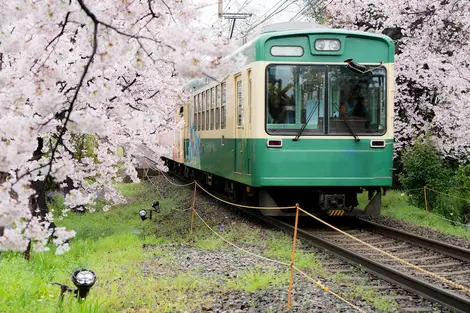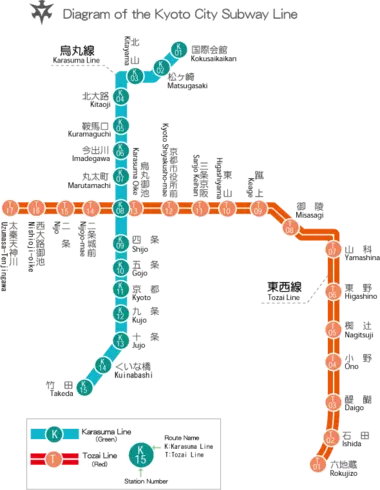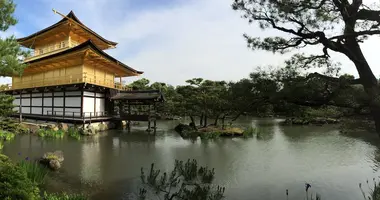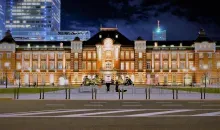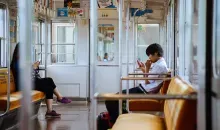Karasuma Line Kyoto Subway 烏丸線
The Karasuma Line of the Kyoto Subway runs north south from Kokusaikaikan Station to Takeda Station via Kyoto Station. The Karasuma Line intersects with the Tozai Line at Karasuma Oike Station.
The north-south Karasuma Line (green) and the east-west Tozai Line (red) are the two lines that make up the Kyoto subway network.
The Karasuma Line was the first of the two to be constructed in 1981 and now runs 13.7km from Kokusaikaikan Station in the northern suburbs via Kyoto Station to Takeda Station in the south, where it connects with the Kintetsu Line to Kintetsu Nara Station in Nara.
The Karasuma Line and Tozai Line intersect at Karasuma Oike Station.
Karasuma Line stations are coded with a "K" and then a number, thus Kokusaikaikan Station is K01.
Karasuma Line Stations
There are 15 stations on the Karasuma Line. From north to south they are Kokusaikaikan, Matsugasaki, Kitayama, Kitaoji, Kuramaguchi, Imadegawa, Marutamachi, Karasuma Oike, Shijo, Gojo, Kyoto Station, Kujo, Jujo, Kuinabashi and Takeda.
Kokusaikaikan Station
Kokusaikaikan Station (国際会館駅; K01) is the northern terminus of the Karasuma Line. From here there are buses to the nearby suburb of Iwakura (bus #24 to Jissoin Temple) and to Ohara (bus #19), famous for its temples set in the mountains of north east Kyoto. Close to Kokusaikaikan Station itself is the huge Kyoto International Conference Center, built in 1996, where the Kyoto Protocol on Climate Change was negotiated in 1997, and the charming Takaragaike Lake.
Matsugasaki Station
Matsugasaki Station (松ヶ崎駅; K02) in Sakyo-ku is located on the trendy Kitayama Dori close to Notre Dame University.
Kitayama Station
Kitayama Station (北山駅; K03) is convenient for both Kyoto Concert Hall and Kyoto Botanical Garden. Kyoto Prefectural University is to the south of the station.
Kitaoji Station
Kitaoji Station (北大路駅; K04) is adjacent to Kitaoji Bus Terminal and Kitaoji Town. Kitaoji Town includes the Vivre shopping mall and Kyoto North Hall (京都市北文化会舘). The large Daitokuji Temple complex is a 10-15 minute walk west from Kitaoji Station.
Matsugasaki Station (松ヶ崎駅; K02) in Sakyo-ku is located on the trendy Kitayama Dori close to Notre Dame University.
Kuramaguchi Station
Kuramaguchi Station (鞍馬口駅; K05) is north of Doshisha University and Shokokuji Temple. This is the station to get off if you are going to walk down the northern part of Teramachi Dori with its many historic temples including nearby Kanga'an, Jozenji and Tenneiji.
Imadegawa Station
Imadegawa Station (今出川駅; K06) is located at the north west corner of the Imperial Palace (Gosho) and close to Doshisha University. Kyoto buses #59, #102, #201 and the #203 stop at Imadegawa Station.
Marutamachi Station
Marutamachi Station (丸太町駅; K07) is located at the south west corner of Kyoto's Imperial Palace. There are lots of sights and places of interest within walking distance of Marutamachi Station, which is at the crossroads of the busy Marutamachi and Karasuma streets. These include Daimaru Villa, Sugawarain Tenmangu Shrine, Go'o Shrine, Kyoto YWCA and St. Agnes Church. Kyoto bus #51 runs north on Karasuma to Ritsumeikan University and stops outside the station.
Karasuma Oike Station
Karasuma Oike Station (烏丸御池駅; K08) is the intersection of the Karasuma and Tozai Lines of Kyoto subway. The area around the station has a number of attractions including Kyoto International Manga Museum and The Museum of Kyoto.
Shijo Station
Shijo Station (四条駅; K09) connects with the Hankyu Kyoto Line at Karasuma Station to Umeda Station in Osaka via Omiya, Saiin, Katsura, Ibaraki and Juso. The station has a number of shops and coin lockers. Near to Shijo Station are several hotels and many restaurants, shops, cafes and bars. Daimaru department store is a short walk north east.
Gojo Station
Gojo Station (五条駅; K10) is north of Higashi Honganji Temple, Sosenji Temple and Shosei-en Garden. The area around Gojo Station is packed with hotels, ryokan and guest houses, especially in the streets east of Higashi Honganji Temple.
Kyoto Station
Kyoto Station (京都駅; K11) is the main transport hub for Kyoto for Tokaido shinkansen bullet trains from Shin-Osaka Station, JR Nagoya Station, Yokohama Station, Shinagawa Station and Tokyo Station.
Kyoto Station also has rail connections on the Tokaido Main Line (JR Kyoto Line) to Osaka Station, Sagano Line (Sanin Main Line) to Nijo Station, Kameoka, Fukuchiyama and eventually Shimonoseki, the JR Nara Line to Nara Station in Nara, and the Kintetsu Kyoto Line to Kintetsu Nara Station. The Haruka Express connects Kyoto Station with Kansai International Airport (KIX) in about 75 minutes via Shin-Osaka and Tennoji Station.
Kyoto Station is also the main bus terminus in Kyoto for local Kyoto buses, Raku buses and highway buses.
The Kyoto Station area is a major shopping and entertainment district with branches of both BIC Camera and Yodobashi Camera nearby and the underground Porta Shopping Center beneath the station.
Kujo Station
Kujo Station (九条駅; K12) in Minami-ku, south of Kyoto Station and east of Toji Temple, is close to Kyoto Terrsa events hall.
Jujo Station
Jujo Station (十条駅; K13) also in Minami-ku, south of Kyoto Station is just west of the Kamo River.
Kuinabashi Station
Kuinabashi Station (くいな橋駅; K14) is in Fushimi-ku near a large Konan home center store.
Takeda Station
Takeda Station (竹田駅; K15) connects with the Kintetsu Kyoto Line to Kintetsu Nara Station. The Kyocera Museum of Art and Pulse Plaza are both walkable from the station (about 20 minutes) or by bus (5 minutes).
Kyoto Subway Fares & Passes
Single fares for adults on the system range from 210-340 yen and 110-170 yen for minors. There are a number of travel cards available including the Kyoto Sightseeing Pass Card (one day card 1,200 yen for adults and 600 yen for children; two-day card is 2000 yen for adults and 1000 yen for children). The pass is valid for the subway and city buses. An all-day inner city bus pass is 500 yen for adults and 200 yen for children.
The Kyoto City Subway One-Day Pass allows unlimited travel on Kyoto's metro and costs 600 yen for adults and 300 yen for children. The pass is available at the Kyoto Tourist Information Center (KYO Navi) on the second floor of the Kyoto Station building. The Kyoto City Subway One-Day Pass includes discounts on admission to Kyoto Municipal Museum of Art, Nijo Castle, Kyoto Zoo, The Museum of Kyoto and Kyoto International Manga Museum.
The pre-paid Surutto Kansai Miyako Card is available in denominations of 1,000 yen, 2,000 yen, 3,000 yen and 5,000 yen and is valid for travel on the Kyoto subway, Kyoto city buses, and the Hankyu and Keihan urban rail networks.
The Kyoto City Bus One-Day Pass allows for unlimited travel on all Kyoto city buses within the downtown fixed rate zone (excluding Arashiyama, Shugakuin, Takao and Iwakura) and costs 500 yen for adults and 250 yen for children. This pass is also available for the Kyoto Station Tourist Information Center.
Although not valid on Kansai's subways, the JR-West Kansai Area Pass can be used on JR trains connecting Kyoto, Osaka, Nara, Kobe, Nishi-Akashi and Himeji as well as the Haruka Express from Kansai International Airport (KIX).
The pass can be bought for 1-day (2000 yen), two successive days (4000 yen), three successive days (5000 yen) and four successive days (6000 yen) - with the half price for children. The JR-West Kansai Area Pass is available from major stations in the Kansai area and overseas branches of JTB, JAL, ANA and major travel agencies.
The Traffica Kyoto Card is a pre-paid travel card available in 1,000 yen and 3,000 yen denominations giving a free bonus of 10% on each card and is valid on Kyoto city subways and buses.
Kyoto's subway runs from around 5.30am until 11.55pm, 7 days a week with reduced services at the weekends and public holidays.
Tunneling was slow during the construction of the two lines to allow time for archeological research on Kyoto's long history. Items of interest found during the construction are displayed at Karasuma Oike Station.




